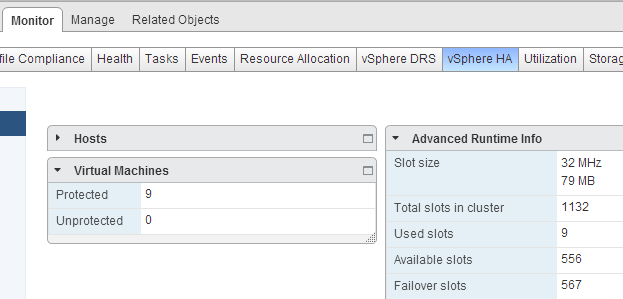Vmware Slot Size Calculation

- Vmware Cluster Slot Size Calculation
- Vmware Slot Size Calculation Formula
- Vmware Slot Size Calculation Chart
- Vmware Slot Size Calculation
Vmware Cluster Slot Size Calculation
You might get a not enough failover resources fault when trying to power on a virtual machine in a vSphere HA cluster.
A High Availability (HA) slot size calculation becomes distorted when using VMware strict admission control The cluster summary displays a message ' Insufficient configured resources to satisfy the desired vSphere HA failover level on the cluster '. Use a calculator. They are all valid in some form or the other and have their specific purpose. I think it basically doesn’t matter if you’re sizing NSX, sizing vSphere or sizing another VMware product, if you use the methods above you get a infrastructure that is able to run your workload. The Host Failures Cluster Tolerates admission control policy is based on the calculation on a slot size comprised of two components, the CPU and memory reservations of a virtual machine. If the calculation of this slot size is skewed by outlier virtual machines, the admission control policy can become too restrictive and result in the inability. VMware Cloud Sizer. The guest memory size should not be set lower than the minimum recommendations of the operating system provider. The New Virtual Machine Wizard sets reasonable defaults for the memory size of a virtual machine, based on the type of the guest operating system and the amount of memory in the host computer.
If you select the Host Failures Cluster Tolerates admission control policy and certain problems arise, you might be prevented from powering on a virtual machine due to insufficient resources.
Cause
This problem can have several causes.- Hosts in the cluster are disconnected, in maintenance mode, not responding, or have a vSphere HA error.
Disconnected and maintenance mode hosts are typically caused by user action. Unresponsive or error-possessing hosts usually result from a more serious problem, for example, hosts or agents have failed or a networking problem exists).
- Cluster contains virtual machines that have much larger memory or CPU reservations than the others.
The Host Failures Cluster Tolerates admission control policy is based on the calculation on a slot size comprised of two components, the CPU and memory reservations of a virtual machine. If the calculation of this slot size is skewed by outlier virtual machines, the admission control policy can become too restrictive and result in the inability to power on virtual machines.
- No free slots in the cluster.
Problems occur if there are no free slots in the cluster or if powering on a virtual machine causes the slot size to increase because it has a larger reservation than existing virtual machines. In either case, you should use the vSphere HA advanced options to reduce the slot size, use a different admission control policy, or modify the policy to tolerate fewer host failures.
View the Advanced Runtime Info pane that appears in the vSphere HA section of the cluster's Monitor tab in the vSphere Web Client. This information pane shows the slot size and how many available slots there are in the cluster. If the slot size appears too high, click on the Resource Allocation tab of the cluster and sort the virtual machines by reservation to determine which have the largest CPU and memory reservations. If there are outlier virtual machines with much higher reservations than the others, consider using a different vSphere HA admission control policy (such as the Percentage of Cluster Resources Reserved admission control policy) or use the vSphere HA advanced options to place an absolute cap on the slot size. Both of these options, however, increase the risk of resource fragmentation.
By Duncan Epping, Principal Architect, VMware
Vmware Slot Size Calculation Formula

Yesterday I received a question on twitter:
Hi, to settle an argument in the office, if no reserves are in place, does number of vCPU’s affect slot size in vSphere 4? Thx 🙂
First of all, what is a slot? The availability guide explains it as follows
A slot is a logical representation of the memory and CPU resources that satisfy the requirements for any powered-on virtual machine in the cluster.
Vmware Slot Size Calculation Chart
In other words a slot is the worst case CPU and Memory reservation scenario for any given virtual machine in a cluster. This slot is used when Admission Control is enabled and “Host Failures Tolerates” has been selected as the admission control policy. The total amount of available resources in the cluster will be divided by the slot size and that dictates how many VMs can be powered on without violating availability constraints. Meaning that it will guarantee that every powered on virtual machine can be failed over.
As said this slot is dictated by the worst case reservation for CPU and Memory. Prior to vSphere 4.0 we used the number of vCPUs to determine the slotsize for CPU as well. But we do not use vCPUs anymore to determine the slot size for CPU. The slotsize for CPU is determined by the highest reservation or 256MHz (vSphere 4.x and prior) / 32MHz (vSphere 5) if no reservation is set.
However, vCPUs can have an impact on your slot… it can have an impact on your memory slotsize. If no reservation is set anywhere HA will use the highest Memory Overhead in your cluster as the slot size for memory. This is where the amount of vCPUs come in to play, the more vCPUs you add to a virtual machine the higher will your memory overhead be.
Vmware Slot Size Calculation
I guess the answer to this question is: For CPU the number of vCPUs does not impact your slotsize, but for memory it may.